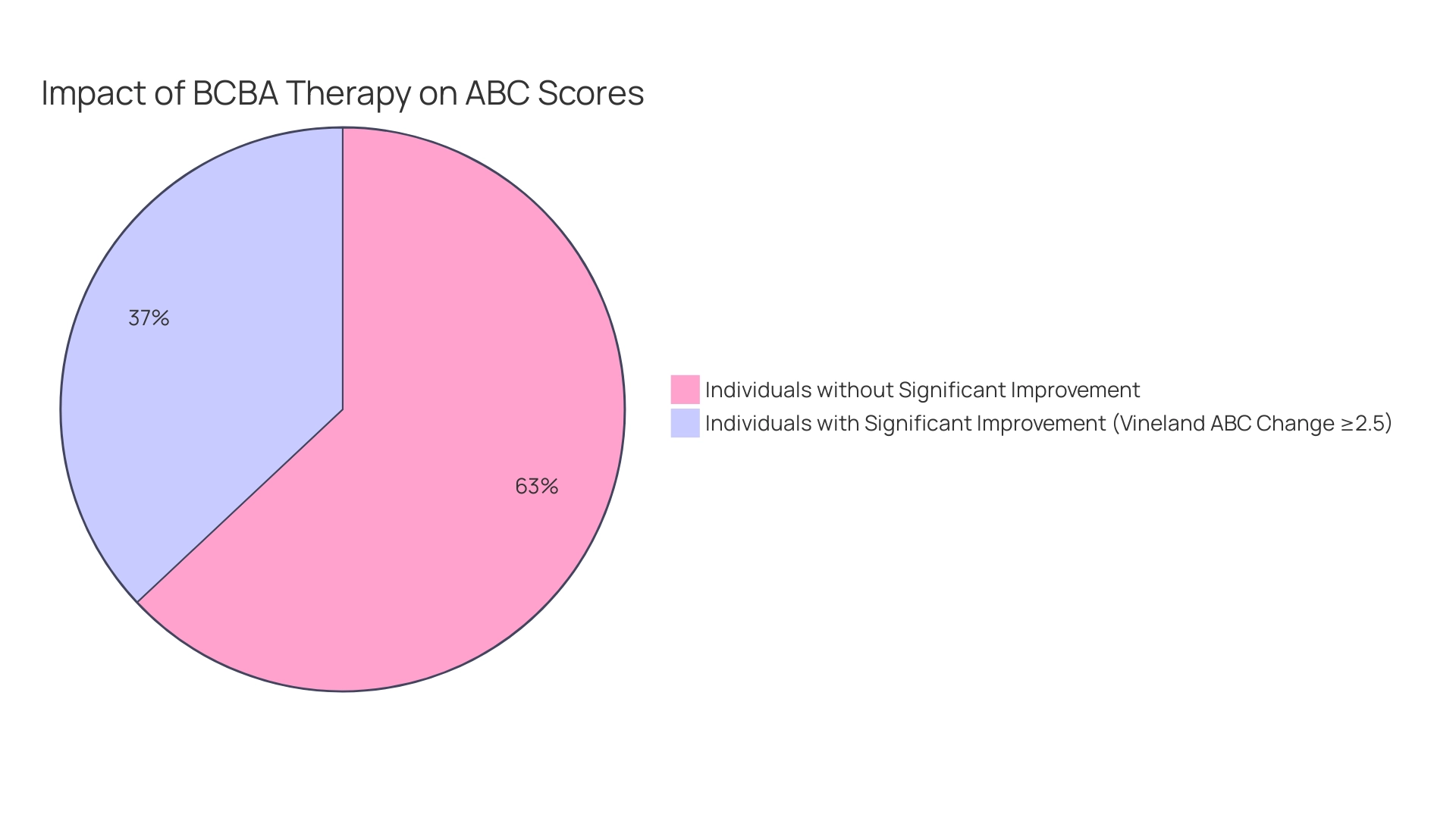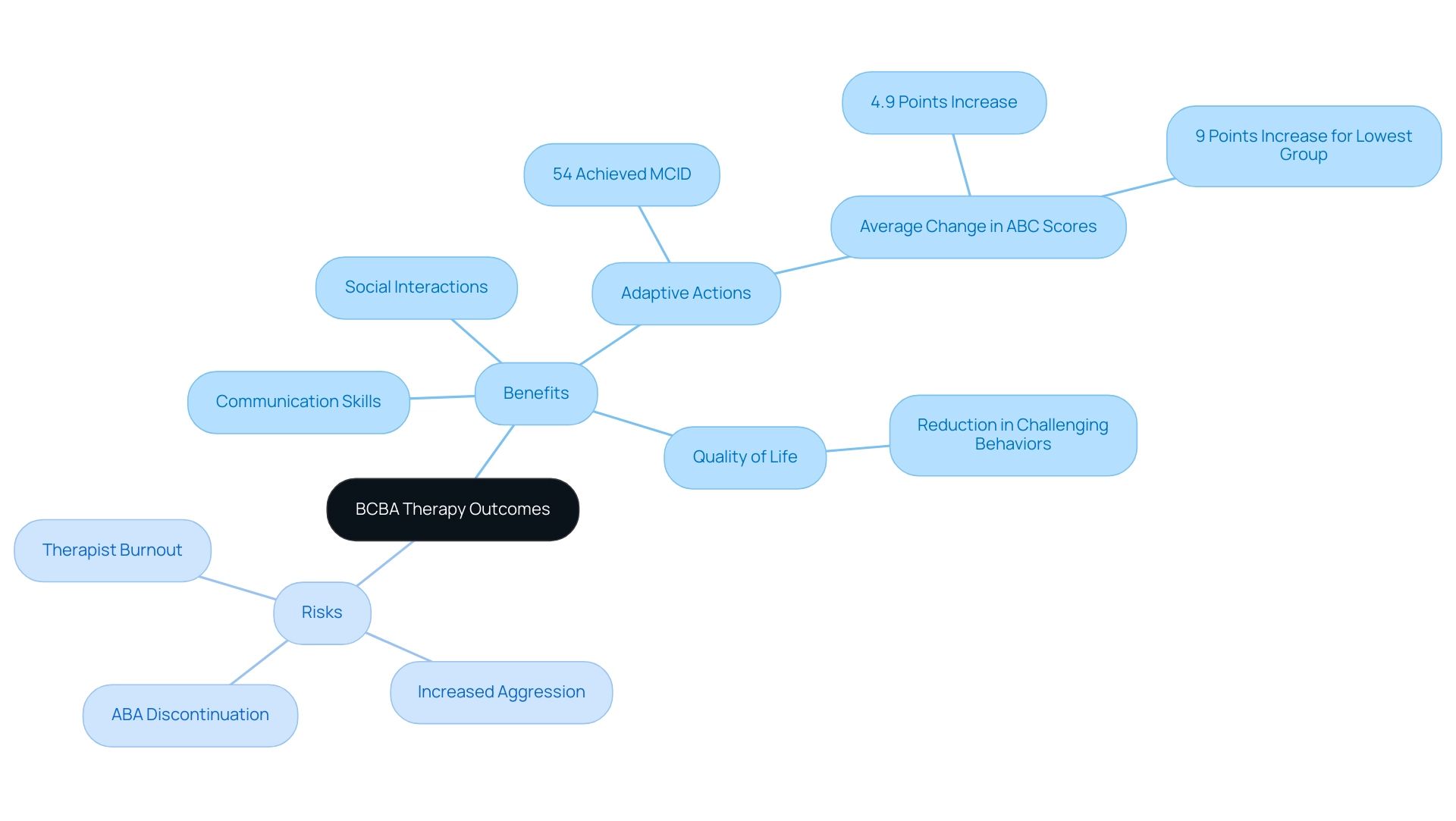Introduction
Navigating the world of behavioral therapy can be a transformative journey for families seeking to support their children with autism. At the forefront of this process is BCBA therapy, a structured approach grounded in the principles of Applied Behavior Analysis (ABA). Board Certified Behavior Analysts (BCBAs) are dedicated professionals who assess individual needs and craft tailored interventions, making a significant impact on children’s development.
As families embark on this path, understanding the roles of BCBAs, the intricacies of treatment plans, and the expected outcomes can empower them to advocate effectively for their child's progress. This article delves into the essential elements of BCBA therapy, offering insights and guidance that will illuminate the way forward for caregivers committed to fostering their child's growth and well-being.
What is BCBA Therapy and Its Importance?
BCBA treatment, or Behavior Analyst intervention, is a meticulously structured approach rooted in the principles of Applied Behavior Analysis (ABA). Board Certified Behavior Analysts (BCBAs) play a crucial role in this process by assessing each individual's unique needs and designing tailored intervention strategies. This treatment holds immense importance as it employs evidence-based techniques to effectively address challenging behaviors, impart new skills, and promote overall functioning.
By concentrating on measurable results, BCBA assistance not only empowers families to monitor their young one's progress but also enables them to make informed choices regarding their development. Notably, a recent analysis on the Adaptive Behavior Composite (ABC) scores revealed that:
- 37.0% of individuals showed a Vineland ABC Change ≥2.5 at 24 months
- Those having the lowest baseline adaptive levels demonstrated significant improvement, achieving an average change of 4.9 points and some reaching a remarkable 9-point increase
Additionally, the adjusted longitudinal model findings suggest that:
- While time in ABA and receiving a full ABA dose were not significantly associated with ABC changes for the overall sample
- The gains associated with each 12-month increment approached statistical significance
This data emphasizes the transformative potential of BCBA therapy in fostering positive developmental outcomes for young individuals. Furthermore, it typically takes anywhere from 2-4 years to complete the necessary education and training for BCBAs, emphasizing the expertise required in this field.

Roles and Responsibilities of a BCBA in Therapy
Board Certified Behavior Analysts (BCBAs) serve a vital role in bcba therapy for individuals with autism. Their responsibilities encompass:
- Conducting thorough assessments to identify each individual's unique needs.
- Developing individualized treatment plans that specifically incorporate bcba therapy to foster growth.
BCBA therapy is instrumental in implementing effective interventions and training parents and caregivers, equipping them with essential techniques to maintain consistency across various environments.
Furthermore, they play a crucial role in monitoring progress in bcba therapy through diligent data collection and analysis, allowing for timely adjustments to treatment plans as needed. While ABA treatment is generally safe and effective, it is important to acknowledge potential risks, such as increased aggression or self-injurious behavior in some individuals with ASD, as well as the risk of burnout for therapists. In Illinois, there are 2,484 ABA therapist jobs available, with an average salary of $37,927, highlighting the demand for these professionals in the field.
A significant instance of successful ABA intervention is the Early Start Denver Model (ESDM), intended for youngsters aged one to four, which employs play-based activities to enhance social and communication abilities. A study found that toddlers receiving ESDM showed significant behavioral improvements and enhanced IQ levels, with reductions in severe autistic symptoms. This collaborative and adaptable approach not only empowers caregivers but also ensures that young ones receive the most effective support on their developmental journey.
As Dr. Ivar Lovaas, the creator of ABA therapy, noted, intensive bcba therapy can yield significant improvements, with nearly half of the participants in his studies becoming 'indistinguishable from their peers.' Such outcomes highlight the influence of bcba therapy in facilitating meaningful change in the lives of individuals with autism.
Collaborating with BCBAs: A Caregiver's Guide
Effective collaboration with Board Certified Behavior Analysts (BCBAs) in bcba therapy hinges on fostering open communication and active participation. Caregivers play a crucial role in this partnership by engaging in discussions during meetings, asking questions, and sharing observations about their offspring's behavior. This collaborative approach not only ensures that caregivers are informed but also allows them to provide valuable feedback on the effectiveness of the treatment.
Regular check-ins are essential for aligning goals and expectations, creating a shared vision for the child's progress.
Moreover, caregivers should not hesitate to seek clarification on any technical terms or strategies that may seem complex. Feeling confident in implementing these techniques at home is vital for the therapy's success. A recent survey revealed that while 58% of leaders in analysis reported offering training on compassion and therapeutic relationships, a significant 82% felt unprepared to address the emotional needs of families.
This highlights the need for caregivers to actively communicate their feelings and concerns, ensuring their voices are heard in the therapeutic process. Furthermore, the survey of caregivers' impressions indicated that average scores below 4 on certain items suggested issues in the therapeutic relationship, underscoring the importance of effective communication. As noted by Pastrana et al., many academic training programs in behavior analysis may not incorporate training in empathy and compassion, which further emphasizes the need for caregivers to advocate for these skills in their interactions with BCBAs.
By prioritizing these best practices, caregivers not only enhance the effectiveness of the treatment but also strengthen their collaboration with BCBAs through bcba therapy, ultimately benefiting their offspring's development.
Understanding Treatment Plans and Techniques in BCBA Therapy
The focus of BCBA therapy is on developing personalized treatment plans that correspond with each individual's unique strengths and challenges. These plans are meticulously designed to include specific goals, strategies, and a variety of techniques such as reinforcement, prompting, and modeling. As a parent advocate, it is vital to familiarize yourself with these components to support your offspring's progress effectively at home.
One of the most widely used techniques is positive reinforcement, which encourages desired behaviors, while systematic approaches are employed to address and reduce challenging behaviors. Recent research emphasizes that youngsters with considerable adaptive difficulties can still show behavioral progress, even with reduced involvement in treatment, highlighting the significance of consistent application of these techniques. Notably, the average cost of BCBA therapy ranges from $120 to $200 per hour, with some families investing upwards of $50,000 per year for treatment, which emphasizes the financial implications of these services.
Furthermore, a case study titled 'Customization of Treatment Dosage' highlighted the importance of tailoring treatment intensity and duration to meet individual client needs, suggesting that providers can maximize functional progress while efficiently utilizing healthcare resources. By understanding and applying these methods, you can foster a nurturing environment that promotes your child's growth and development. Furthermore, it's important to mention that California has the highest number of Registered Behavior Technicians (RBTs), making up around 15% of all RBTs in the US, which highlights the accessibility of resources in ABA services.
Expected Outcomes and Benefits of BCBA Therapy
Caregivers can expect numerous positive results from bcba therapy, particularly in enhancing communication skills, social interactions, and adaptive actions. Recent findings reveal that 54% of youngsters achieved a minimal clinically important difference (MCID) in adaptive performance scores over a 24-month period, showcasing the potential for significant improvement. Numerous youngsters also experience a notable reduction in challenging behaviors while enhancing their functional skills, which ultimately leads to a better quality of life.
As emphasized by Dr. Kristen R Choi, PhD, MS, RN, "The purpose of this study was to examine patterns of service receipt and patient outcomes for children receiving Applied Behavior Analysis (ABA) for Autism Spectrum Disorder in an integrated healthcare system where commercially insured children were covered by a state autism mandate." However, it is important to acknowledge that high rates of ABA discontinuation and low dosing may limit the benefits of treatment, despite mandated commercial insurance coverage. Additionally, while ABA treatment is generally safe and effective, there may be risks such as increased aggression or self-injurious behavior in some individuals with ASD, as well as burnout for therapists.
Success in bcba therapy is meticulously tracked through ongoing assessments and data collection, empowering families to observe their loved one's progress over time. It is essential to celebrate small milestones along the way, as each incremental improvement plays a crucial role in the child's overall growth and development.

Conclusion
Navigating the complexities of BCBA therapy opens doors to transformative growth for children with autism. The structured approach rooted in Applied Behavior Analysis (ABA) empowers families by providing tailored interventions that address unique needs, foster skill development, and promote overall functioning. The role of Board Certified Behavior Analysts (BCBAs) is pivotal, as they not only design and implement individualized treatment plans but also equip caregivers with the tools necessary for consistent support at home.
Effective collaboration between caregivers and BCBAs enhances the therapeutic experience. Open communication, regular check-ins, and active participation ensure that treatment remains aligned with the child's evolving needs. Understanding the intricacies of treatment plans and techniques, such as positive reinforcement and systematic strategies, allows caregivers to advocate confidently for their child's progress, ultimately reinforcing the effectiveness of therapy.
The anticipated outcomes of BCBA therapy highlight its potential to significantly improve communication, social interactions, and adaptive behaviors. While challenges may arise, such as the risk of therapy discontinuation or the need for ongoing assessments, the journey of growth is marked by meaningful milestones. Each step forward, no matter how small, contributes to a child's overall development and quality of life. Embracing this journey with knowledge and support not only empowers families but also fosters a brighter future for children with autism.
Frequently Asked Questions
What is BCBA treatment?
BCBA treatment, or Behavior Analyst intervention, is a structured approach based on the principles of Applied Behavior Analysis (ABA), designed to address individual needs through tailored intervention strategies.
What role do Board Certified Behavior Analysts (BCBAs) play in BCBA treatment?
BCBAs assess individual needs, develop personalized treatment plans, implement interventions, train parents and caregivers, and monitor progress through data collection and analysis.
How does BCBA treatment benefit individuals with challenging behaviors?
It employs evidence-based techniques to address challenging behaviors, teach new skills, and promote overall functioning, leading to positive developmental outcomes.
What evidence supports the effectiveness of BCBA therapy?
A recent analysis showed that 37.0% of individuals had a significant improvement in Vineland ABC scores, with those at the lowest baseline adaptive levels achieving an average change of 4.9 points, some even reaching a 9-point increase.
How long does it take to become a BCBA?
It typically takes 2-4 years to complete the necessary education and training to become a Board Certified Behavior Analyst.
What are some potential risks associated with ABA treatment?
Potential risks include increased aggression or self-injurious behavior in some individuals with Autism Spectrum Disorder (ASD) and the risk of burnout for therapists.
What is the Early Start Denver Model (ESDM)?
ESDM is an ABA intervention designed for children aged one to four, utilizing play-based activities to improve social and communication skills, and has shown significant behavioral improvements and enhanced IQ levels in toddlers.
What are the job prospects for ABA therapists in Illinois?
There are 2,484 ABA therapist jobs available in Illinois, with an average salary of $37,927, indicating a strong demand for these professionals in the field.
What did Dr. Ivar Lovaas state about the outcomes of intensive BCBA therapy?
Dr. Lovaas noted that intensive BCBA therapy can lead to significant improvements, with nearly half of the participants in his studies becoming indistinguishable from their peers.




